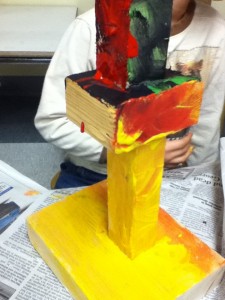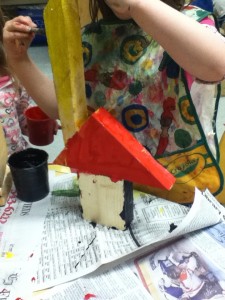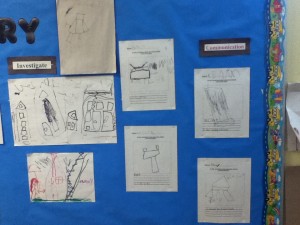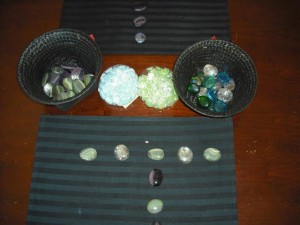Each student created a little notebook that they decorated and I placed an inquiry letter inside. This letter outlines 4 easy steps on how to start your own inquiry over the summer. We also discussed ideas, how to use the book, and places they may want to store it so it does not get lost!
I asked that they share their discoveries with us in September!
]]>



 This student independently drew a picture of his neighbourhood when we were writing in our journals. He carefully selected shapes that are parts of a building, told me about the buildings-some stores and houses and added stairs that go to the bed on the top floor (blueprints show stairs!).
This student independently drew a picture of his neighbourhood when we were writing in our journals. He carefully selected shapes that are parts of a building, told me about the buildings-some stores and houses and added stairs that go to the bed on the top floor (blueprints show stairs!).
The program has evolved with the introduction of FDK. Educators are more facilitators, listening to the children’s ideas for exploration (the emerging curriculum), placing materials out that are more exploratory–that provoke questioning and research to find out answers. When children are engaged during play time many skills are developing including reading and writing. Oral language is a huge premise in the entire program. Talking is most critical! Getting children to talk and model appropriate language is the foundation. http://earlylearningcentral.ca/wp-content/uploads/2009/02/literacy-30-used-mar-4.pdf . Here are some great prompts and questions to get you thinking about how to assess oral language and some self-reflective questions about the program in your classroom.
Initially in the school year rules and routines are established that need to be followed both in and out of the classroom. Some children have not been expose to a structured routine/environment at this point in their life and it may take sometime to get them to know the expectations. As they enter opportunities at various point in the classroom the ability to problem-solve, get along with others, share toys, ask for support is all part of self-regulation that will be needed for grade 1 and up and for the rest of their lives.
The two year play-based program provides children time to hone those skills necessary for life. When they enter the block centre or dramatic play they set their own rules and self-monitor how roles should play out. It is at this point they will have to regulate what appropriate behaviours (within the paramaters) are acceptable–they need to talk out disagreements using problem-solving skills, they need to share and/or take turns, ask for help when needed, and adapt to various situations in the day. Within the program the Educators model appropriate behaviours (some boards may follow programs like Second Steps to support), and provide ample opportunities for children to work on self-regulation at different points throughout the day.
In my experience it does take some time for many of the children to acquire these skills. They need to have a firm base of appropriate behaviours before they move up the grades. In my opinion when children don’t know how to self-regulate they take on less desirable behaviours and find themselves in trouble. In the K program it is important to build in the leadership skills by giving them roles and responsibilities, make them feel valued, and allow them to make good/positive choices. The structure of the program then changes are they move to grade 1 where they are expected to sit long for lessons, often more large group teaching occurs, and pencil/paper tasks are required for learning. I am a believer that the inquiry model is appropriate for all grades due to the fact that many skill sets can be acquired with a more emergent curriculum model. Having taught in all primary grades there are some great opportunities to apply the inquiry model into social studies, science where we can apply math and literacy skills and meet the curriculum expectations.
The New Learner:
When children leave the K program they are learning to be independent thinkers, ask questions, apply learning and ideas into different contexts–link the concepts into new situations, have a firm base on printing, basic math concepts, reading readiness skills, have the ability to appropriately problem solve, and understand rules and routines in a structure environment.
]]>Focusing on the classroom environment is important in engaging students. It tells them what is valued, what is important in learning and it will certainly set a tone for learning. As I return to my classroom I am reflecting on what has worked and what hasn’t and other ways I can give students opportunities to learn new things.
For example, more computer access to seek information on our inquiry projects, adding mirrors to our light table area, looking at my shelving space and how I can organized various materials to make things more appealing to my students, and creating more centres of inquiry. With all this happening, how can I better assess my students through documentation. I created a new form that my ECE partner and I can track conversations in a more organized fashion and we can simply slip the forms into portfolios as opposed to always typing the information out. I also gathered more clipboards to have at each station and labelled these as our documentation boards.
Here are a few photos of centre idea where children can be creative.
This is a great little centre that focuses around found materials. Students can develop their fine motor skills in connection to math or art. The mats are earth tone in colour and are used as a different surface for children to create.
 This centre idea uses material found at the dollar store. There are jewels and stones of different colours that you can place in different baskets sorted by colour/shapes/size its up to you. You can use placemats, black felt, photo frames that students can use to display their different art pieces. Again, you can connect to math and a great oral language opportunity for the children.
This centre idea uses material found at the dollar store. There are jewels and stones of different colours that you can place in different baskets sorted by colour/shapes/size its up to you. You can use placemats, black felt, photo frames that students can use to display their different art pieces. Again, you can connect to math and a great oral language opportunity for the children.
Here are some pictures of one environment http://earlylearningcentral.ca/?page_id=2138 to get you thinking about your space. Reflective Questions: What do you do when the environment is not working for your students? How can you place materials that will engage student learning? How can I document student learning and display it?
]]>This story not only began the discussion of snow, but hot and cold, the fridge vs the freezer, experimenting with different ice cubes wrapped in various materials like newspapers, foil, paper, and with salt (Which melts faster?) and we tried attaching ice cubes to string using salt. Throughout these experiments children learned new vocabulary, used a thermometer to record temperature, and they observed water changing from a liquid to a solid, they recorded time and charted change.
Throughout this approximate 6 week inquiry on snow, the children communicated their learning in written and visual form to include in their documentation books. It allowed us to explore many new things and the children had so much fun.
]]>This great line….
]]>
An example of differentiating instruction that was supportive in strengthening skills in literacy was to use visuals. When I chose my read aloud for the week, I ensured that when we discussed “characters”(for example) I had copied pictures either photocopied or in colour, I also included a drama piece when we focused on retelling the story. When it came time to work one-on-one to test comprehension, I often used the pictures of the characters to help them. Another idea that I also used was to photocopy 5 main parts of the story and have the children assemble it in order and orally tell me what they remembered from the story.
In looking at the environment of the classroom, surely posting up student work to display what they have learned makes them feel valued. Posting pictures of the students while completing various tasks, displaying learning charts/anchor charts from the inquiry process with children’s names next to their ideas, and having clear learning goals discussed and displayed in the centres helps guide learning in the classroom. It also displays to parents what the children are learning. The entire classroom environment sets the tone for learning and really shows what is valued and important. In our school we have implemented a program called First Steps. We talk about setting rules for circle time through simple songs, being respectful, and we centre on student strengths. Attached is a great checklist to reflect on your classroom and school environment http://earlylearningcentral.ca/wp-content/uploads/2009/02/R-of-M-grade-1-creating-the-whole-school-learning-environemnt.pdf . Reflecting the culture of your students into the classroom also provides a great learning point. Since most of my students are from an aboriginal background we discuss the medicine wheel and how it ties into nature. I have framed pictures of the students dancing in powwows, books and artifacts are displayed around the room. Reading resources have been easily integrated into my reading program. The use of visuals (pictures, book, artifacts) have been introduced in my oral language groups as a starting point for discussions.
If children have special needs, an IEP is a place where you would need to document specific learning instruction (accommodations) that will best meet the students learning goals. In Kindergarten, it starts with clear goals, visuals, and oral discussion for them to be successful.
]]>Written Observation or Anecdotal records details some critical information about how to collect that information and when it is applicable. Recording the time, date onto the back of work samples provides a context. It also discusses some great points about factors that affect observation records.
On p. 6 of the pdf there is a great chart that gives some ideas on “what you need to find out” and the “tools/strategies” you can use to assess. If you do collect work samples; a binder, a folder or scrapbook is a great way to house the information.
When assessing students it is always important to collect information over time so that you get their best work and really see their full potential. Keep in mind that accommodations may be beneficial for many of your students and as you meet with each child, you can see their unique qualities and change as needed. On p.5 (p.30-31) of the pdf, there are ideas for instructional, environmental, and assessment accommodations.
I encourage you to read the section on Assessment in the Thinking it Through document as it give some great tools and strategies, some “ahas”, and there may be something new that can add a creative twist to assessments!!
]]>Last year I revamped my newsletters and tailored them to show “what” we are currently learning as opposed to what we “will” be learning. The layout was about 8 pages and it was in a book format. I shared pictures of students engaged in learning with the oral conversations listed below. I tried to include about 10 students or so and if I missed anyone I included them in the following newsletter. I focused on our inquiry projects, but also included the activities that related to math, literacy etc. On the last page I created a section for parents to provide me with feedback about what they saw or anything that they wanted to learn more about. Be sure to check permissions before sending out photos!
I really enjoyed creating these newsletters and it was relevant to what we were doing. Any upcoming events or information I need to pass along outside of the learning, I created a small section and kept it brief—my point was to showcase the student learning! Well worth the extra time.
is important because it gives parents an idea of what the children are learning and certainly includes them in the learning going on in the classroom.
]]>